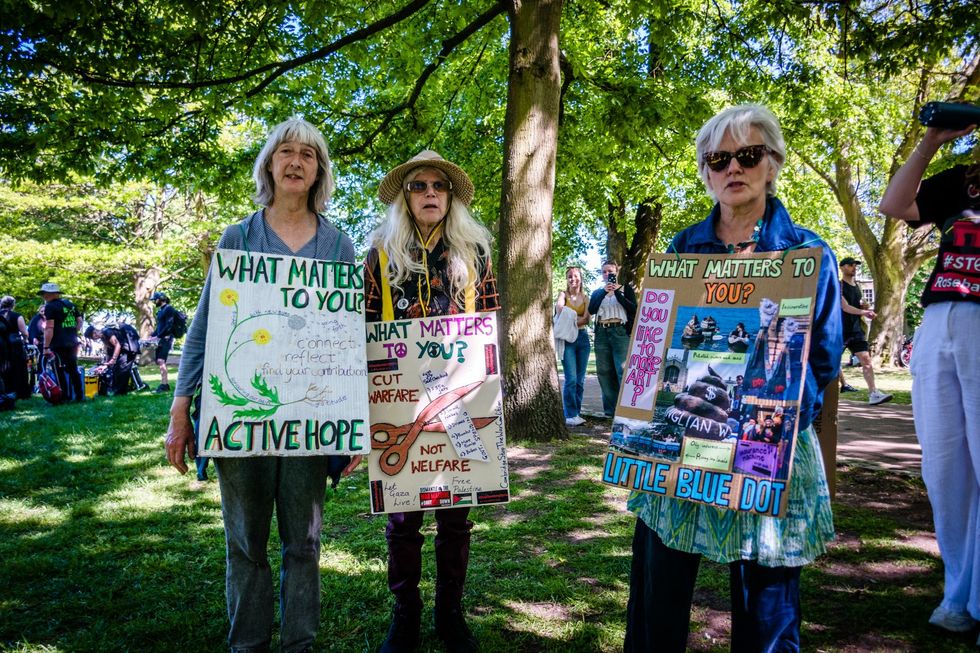

SUBSCRIBE TO OUR FREE NEWSLETTER
Daily news & progressive opinion—funded by the people, not the corporations—delivered straight to your inbox.
5
#000000
#FFFFFF
To donate by check, phone, or other method, see our More Ways to Give page.


Daily news & progressive opinion—funded by the people, not the corporations—delivered straight to your inbox.

Noah Greenwald, Center for Biological Diversity, (503) 484-7495
Chris Frissell, Pacific Rivers Council, (406) 471-3167
Roland Knapp, University of California, Sierra Nevada Aquatic Research Laboratory, (760) 647-0034
TheSacramento Superior Court has ordered the
California Department of Fish and Game into talks with Pacific Rivers
Council and the Center for Biological Diversity to develop interim
measures to limit harm to native species caused by fish stocking. The
intent is to minimize the adverse effect that hatchery-raised fish
inflict on sensitive native fish and amphibian species while the
Department prepares an Environmental Impact Report under the California
Environmental Quality Act.
"Interim measures
limiting stocking are needed to help save California's native fish and
frogs from extinction," said Noah Greenwald, biodiversity program
director for the Center for Biological Diversity. "Fish and Game should
still be able to stock hatchery fish, but in places where they won't
harm native species."
The court ruled in May 2007
that fish stocking has "significant environmental impacts" on "aquatic
ecosystems" and "in particular, on native species of fish, amphibians
and insects, some of which are threatened or endangered." The court
ordered the Department to analyze and mitigate the impacts of the
stocking program in an Environmental Impact Report, or EIR, by the end
of 2008. The Department returned to court last month to ask for a
one-year extension, to January 2010, because the agency has made little
progress on the EIR.
To reduce the impact of the
Department's delay, the Center and Pacific Rivers Council asked for
interim restrictions on stocking, including not stocking in areas where
sensitive species such as California golden trout, Santa Ana sucker,
mountain yellow-legged frog, and Cascades frog, are known to be present
or where the Department has yet to survey. Judge Patrick Marlette
stated in a tentative order that such interim measures may be
necessary, but gave the Department until November 24th to negotiate an
agreement with the two organizations to determine where stocking could
take place pending completion of the EIR. If no agreement is reached,
the Judge indicated that he would consider limiting stocking only to
water bodies where no at-risk species occur on an interim basis, as
proposed by petitioners.
"The far reaching,
often disastrous consequences of stocking hatchery fish have been known
for decades," said Dr. Chris Frissell, Director of Science and
Conservation for Pacific Rivers Council. "It's far past time the
Department of Fish and Game completed a credible review of the
environmental impacts of its hatchery program and identified the steps
needed to limit its impacts to sensitive native species, as many other
states have done. Interim measures are merely a short-term safety net
to protect vulnerable species and waters until the State meets its
legal mandate to produce a report."
The required
California Environmental Quality Act environmental review will for the
first time provide the public and independent wildlife experts with an
opportunity to actively participate in how the Department can improve
management of the statewide fish-stocking program to better meet the
needs of both California's native species and recreational anglers.
Suspending the stocking of non-native fish in certain areas while the
review is being conducted will allow the Department to keep open as
many options regarding future management as possible by ensuring that
interim stocking does not further jeopardize any of California's
wildlife.
"The Department needs to consider the environmental impacts of its fish-stocking program before
it stocks more fish into aquatic strongholds," said Frissell, who has
published numerous scientific articles on the ecology of native fish
and wildlife species. "This is the only way that the Department can be
sure that it is not causing or contributing to the loss of the last
remaining populations of these native California animals and the
habitat they depend on."
Removing non-native fish
once they have been introduced is difficult, expensive and can cause
further damage to sensitive species. Many of the sensitive fish and
amphibian species are already so seriously depleted by past impacts,
including fish stocking, that even one more year of stocking could
cause irreversible loss of some populations.
"The
mountain yellow-legged frog has disappeared from more than 90% of its
former range in the Sierra Nevada, and introduced trout are an
important cause of this decline," stated research biologist Dr. Roland
Knapp. Likewise, unintended consequences of stocking nonnative trout
without needed precautions have seriously compromised and set back the
State's own conservation and recovery efforts for its imperiled native
golden and redband trout. "On a hopeful note, a cessation of stocking
and the removal of nonnative trout from key sites can allow the
recovery of mountain-yellow legged frogs and other native species."
The Pacific Rivers Council and Center for Biological Diversity are
represented by Deborah A. Sivas of the Environmental Law Clinic, Mills
Legal Clinic at Stanford Law School. For more information about the
lawsuit go to www.pacrivers.org or www.biologicaldiversity.org.
At the Center for Biological Diversity, we believe that the welfare of human beings is deeply linked to nature — to the existence in our world of a vast diversity of wild animals and plants. Because diversity has intrinsic value, and because its loss impoverishes society, we work to secure a future for all species, great and small, hovering on the brink of extinction. We do so through science, law and creative media, with a focus on protecting the lands, waters and climate that species need to survive.
(520) 623-5252"We felt we needed a physical space where we could grieve together for what we are losing, and reflect on how to respond to the challenge now in front of us," said Alex Martin of Extinction Rebellion Cambridge.
Extinction Rebellion and other climate organizations on Saturday held a funeral for the Paris agreement's 1.5ºC temperature target in Cambridge, England.
"The mock funeral idea grew out of the need to process the enormity and sadness of this moment," Alex Martin of Extinction Rebellion (XR) Cambridge said in a statement. "While many people are distracted by 1,001 things on their phones, we felt we needed a physical space where we could grieve together for what we are losing, and reflect on how to respond to the challenge now in front of us."
Almost a decade ago, parties to the Paris treaty agreed to work toward limiting temperature rise this century to 1.5ºC—but 2024 was the hottest year in human history, and countries around the world show no signs of reining in planet-wrecking fossil fuels anywhere near the degree that scientists warn is necessary to prevent catastrophic climate breakdown.
"Crossing 1.5ºC for a whole calendar year is a wake-up call for the world," said Olympic gold medalist and XR U.K. spokesperson Etienne Stott, highlighting another alarming record from last year. "If we want to avoid crossing further tipping points we need a complete transformation of society."

Scientists from universities in the United Kingdom and Germany warned in a peer-reviewed paper published in the journal Earth System Dynamics last month that humankind is at risk of triggering various climate tipping points absent urgent action to dramatically reduce emissions from fossil fuels.
"There are levers policymakers can pull to rapidly phase out fossil fuels, but this requires standing up to powerful interests," Stott said Saturday. "Activists need to build power, resilience, and the world we want to see in our communities; but we also need to keep seeking the spark that will cause the worldwide transformation we need to see."
In addition to the Cambridge and U.K. arms of Extinction Rebellion, Saturday's action was organized by Cambridge Greenpeace, Cambridge Stop the War, and the Organization of Radical Cambridge Activists (ORCA).
Varsity, the independent student newspaper at the University of Cambridge, reported that the marchers "rallied at Christ's Pieces, where they heard from one of the organizers, who emphasised the harm caused by exceeding 1.5ºC of warming."
"The march then proceeded up Christ's Lane and down Sidney Street, led by a group of 'Red Rebels,' dressed in red robes with faces painted white, followed by 'pall bearers' carrying coffins painted black, with the words 'Inaction Is Death' in white," according to Varsity. "The procession was completed by a samba band who drummed as they walked, followed by protesters carrying a large sign reading 'Don't silence the science,' along with many other smaller placards."

Photos from organizers show participants displaying banners with messages such as "No Future on a Dead Planet," and additional messages painted on the black coffins: "1.5ºC Is Dead," "Act Now," "Ecocide," "RIP Earth," and "Web of Life."
"Politicians have broken their promises to keep global temperature rises to a livable 1.5ºC," declared Zoe Flint, a spokesperson for XR Cambridge. "For decades, people around the world have been resisting environmental devastation in their own communities and beyond—often facing state repression and violence as a result."
"With dozens of political protesters now in prison in this country, that repression has come to the U.K. too," Flint noted. "But when those least responsible for climate breakdown suffer the worst effects, we can't afford to give up the fight."
Parties to the Paris agreement are set to gather next in November at the United Nations climate summit, COP30, in Belém, Brazil.
"Despite their rhetoric," Republicans are "failing to deliver for millions of working-class families," said one tax expert.
Since Republican leadership in the U.S. House of Representatives on Friday evening released tax-related legislative language and announced a markup for President Donald Trump's "One, Big, Beautiful Bill," economic justice advocates have sounded the alarm.
House Ways and Means Committee Chair Jason Smith (R-Mo.) scheduled a Tuesday afternoon hearing, shared 28 pages of legislative proposals for the reconciliation package, and positively framed the Tax Cuts and Jobs Act (TCJA) that congressional Republicans passed and Trump signed in 2017. The tax reform push comes just months away from parts of that law—which critics call the "GOP tax scam"—expiring.
"So far this costly bill appears to double down on trickle down, with huge tax cuts that will further enrich the rich and not much for the rest of us," said Amy Hanauer, executive director of the Institute on Taxation and Economic Policy (ITEP), in a Saturday statement. "What's more, many of the modest improvements for lower- and middle-income families are proposed to be temporary, whereas the benefits for the wealthiest are proposed to be permanent."
Hanauer's group specifically noted that "the 2017 changes to personal income tax rates and brackets would be made permanent," as would the deduction that individuals receive from "pass-through" businesses, which would also increase from 20% to 22%. Republicans also want to hike the estate tax exemption from $13.99 million per spouse to $15 million and have it continue to rise with inflation.
"The very generous version of a tax break for offshore profits (the GILTI deduction) would be made permanent, effectively taxing the foreign profits of American corporations half as much (at most) as their domestic profits are taxed," the think tank highlighted.
ITEP also flagged that "the 2017 change to the standard deduction would be made permanent, and a temporary four-year boost would bump it up to $16,000 for individuals, $24,000 for taxpayers filing as head of household, and $32,000 for married couples."
"The child tax credit would temporarily increase to $2,500 per child from $2,000 per child for four years, but 4.5 million citizen kids would lose access to the... CTC due to a requirement that both their parents have Social Security numbers," the group warned.
Chuck Marr, vice president of federal tax policy at the Center on Budget and Policy Priorities, similarly said in a series of Friday social media posts that the emerging "bill appears highly skewed to the wealthy, [with] several regressive expansions of 2017 tax cuts and full of costly timing gimmicks, while, despite their rhetoric, failing to deliver for millions of working-class families."
Like ITEP, Marr blasted House Republicans for their "glaring failure" on the CTC as well as for continuing to push the pass-through deduction and estate tax exemption, the latter of which he called "the most skewed provision of the 2017 law."
"On Tuesday, House Republicans in one committee will be taking away people's health insurance and in another taking away food assistance, while in a third they will be permanently increasing the amount the wealthiest heirs in the country can inherit tax-free," he said, stressing that the GOP aims to pay for its tax giveaways to the rich by gutting Medicaid and the Supplemental Nutrition Assistance Program (SNAP).
"It also looks like House Republicans are repeating a brazen pattern from 2017: Make the provisions for rich people permanent (recall the 2017 massive corporate rate cut) while making the broader provisions temporary—backwards priorities," Marr declared.
"So tonight we've learned—despite all the Trump bluster—House Republicans are proposing more tax cuts for the wealthy, increasing its already bloated costs, while harshly failing to deliver for millions of families he promised to help," he concluded.
Smith's legislative text notably does not include letting the top tax rate revert from 37% to 39.6% for taxable income greater than $5 million for married couples and $2.5 million—an idea that Trump floated this week but, as NBC Newsput it, "is running into a buzz saw of opposition in the Republican Party."
Trump said on his Truth Social Platform early Friday: "The problem with even a 'TINY' tax increase for the RICH, which I and all others would graciously accept in order to help the lower and middle income workers, is that the Radical Left Democrat Lunatics would go around screaming, 'Read my lips,' the fabled Quote by George Bush the Elder that is said to have cost him the Election. NO, Ross Perot cost him the Election! In any event, Republicans should probably not do it, but I'm OK if they do!!!"
While Trump's comments this week have generated headlines about the president proposing "to raise income taxes on wealthy Americans," ITEP's Steve Wamhoff and Carl Davis argued in a blog post that "nobody should be deceived: The wealthiest taxpayers got enormous tax breaks from Trump's 2017 law and are getting additional large tax breaks in what Trump and Republicans are proposing now."
"We need legislation that requires rich people to pay more taxes, not less," they added. "The Republican legislation will do the opposite, regardless of whether or not Congress includes this latest suggestion from Donald Trump."
Leaders around the world have urged de-escalation between the nuclear-armed nations since the massacre in Indian-occupied Kashmir.
This is a developing story... Please check back for possible updates...
India and Pakistan accused each other of violating a cease-fire that had been announced Saturday by officials from both countries and U.S. President Donald Trump amid global fears of escalating tit-for-tat strikes between the nuclear-armed neighbors in the wake of last month's Pahalgam massacre in Indian-occupied Kashmir.
"Within hours, blasts were reported from the main cities of Indian Kashmir, the center of four days of fighting," Reutersreported, citing authorities, residents, and witnesses. "Blasts were heard in Srinagar and Jammu, and projectiles and flashes were seen in the night sky over Jammu, similar to the events of the previous evening."
Drop Site News noted that Indian Foreign Secretary Vikram Misri accused Pakistan of "repeated violations" of the deal.
However, Pakistan's information minister, Ataullah Tarar, toldGeo News, that "violation of cease-fire agreement from our side is out of question."
The Pakistani Ministry of Foreign Affairs later released a statement saying that it "remains committed to faithful implementation" of the deal, accusing India of committing violations, and stressing that troops on the ground "should also exercise restraint."
Earlier Saturday, the Indian minister, Misri, had confirmed the cease-fire agreement, saying that "it was agreed that both sides would stop all firing and military action on land and in the air and sea."
Indian officials have not publicly credited the United States for the deal, while Pakistani leaders have. Pakistani Deputy Prime Minister and Foreign Minister Ishaq Dar "specifically acknowledged the role played by U.S. Secretary of State Marco Rubio in the process," according toGeo News.
Shehbaz Sharif, Pakistan's prime minister, said on social media that "we thank President Trump for his leadership and proactive role for peace in the region."
The U.S. president had said on his Truth Social platform: "After a long night of talks mediated by the United States, I am pleased to announce that India and Pakistan have agreed to a FULL AND IMMEDIATE CEASE-FIRE. Congratulations to both Countries on using Common Sense and Great Intelligence. Thank you for your attention to this matter!"
Leaders around the world, including United Nations Secretary-General António Guterres, have urged diplomacy and restraint since militants attacked Hindu tourists and killed 26 people in Kashmir last month.
After Saturday's cease-fire announcement, Farhan Haq, deputy spokesperson for the U.N. chief, toldPTI that "we are monitoring but we welcome all efforts to de-escalate the conflict."
Sources from India and Pakistan's governments toldReuters that the Indus Waters Treaty was not part of the deal. India withdrew from the decades-old water-sharing pact after the April attack in Kashmir.